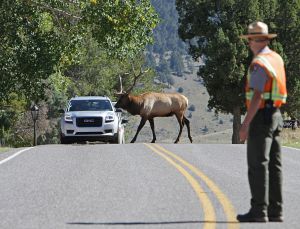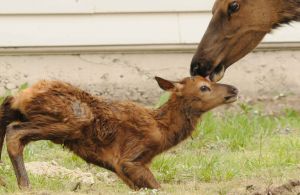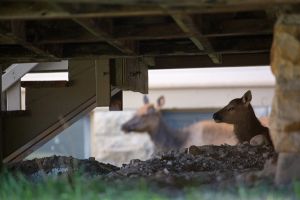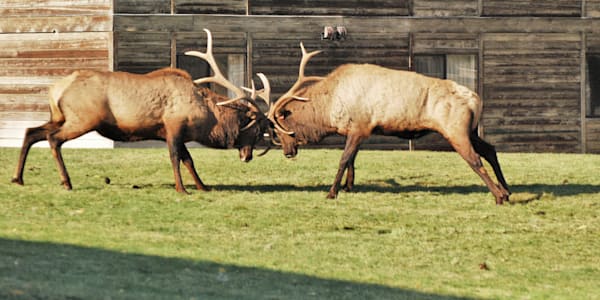Elk Safety in Yellowstone National Park
Elk are truly a sight to behold in the sprawling landscapes of Yellowstone. Their summer population ranges from 10,000 to 20,000 and around 5,000 in the winter, so they are a common sight in the greater Yellowstone ecosystem. Viewing elk in Yellowstone can be the encounter of a lifetime, but it needs to be done responsibly; safety should be a priority.
You are responsible for your own safety. Always stay at least 25 yards (23 m) away from elk. Elk can become additionally aggressive two times a year: during the fall rut (mating season) and in the spring when calves are born. Be aware that during these times, elk can be highly aggressive and will charge cars and people. DO NOT approach on foot or in your vehicle.

Elk Calves
The elk calving season typically begins as the park’s vegetation starts to grow in May and June. High-nutrition plant phases allow mothers and calves to build up fat reserves. When born, calves are brown with white spots and have little scent, providing good camouflage from predators. They can walk within an hour of birth but spend much of their first week to 10 days bedded down in the sage and brush between nursing sessions. Soon after, they begin grazing with their mothers and join a herd of other cows and calves.

Springtime brings the birth of new life to many species in Yellowstone. Mother elk often aggressively defend newborn calves and hide them near buildings and cars. Cow elk may charge or kick to protect their calf, so stay alert. Be cautious when exiting buildings or approaching blind corners. Always stay at least 25 yards (23 m) away from elk. The animals in Yellowstone are wild and unpredictable, no matter how calm they appear. If you come across an elk calf alone and hidden away, slowly back away, looking for the mother nearby. Notify park rangers so they can keep other visitors aware and safe.

Viewing these spring babies with a bit of respect for mother elk is surely delightful. So grab your telephoto lens, spotting scope, or binoculars and enjoy the cute antics of Yellowstone’s babies.
Elk Rut
The elk mating season, or rut, begins in late August- early September. Otherworldly bugles—the vocalizing of bull elk—cut through the cool fall air, and the herds coalesce into larger groups. Bull elk compete for access to a group of a dozen or so females, known as a harem. Watching and listening to the eerie bugle of the bulls as they jockey for position and guard their harems is one of the true highlights of fall in Yellowstone.
Listen to a bull elk bugle ranging from low throaty sounds or deep grunts to high-pitched whistles.
Mammoth Hot Springs is grand central for the elk rut. However, watching in the village can be crowded and chaotic at times. To find elk without the crowds, try exploring Swan Lake Flats, Lamar Valley, and Madison Valley.
While everyone hopes to see a fight between bull elk, it doesn’t happen as often as you might think. Once the peak of the mating season arrives, the bulls will have established a pecking order. Fights are rare because no one wants to get hurt; elk rely on vocal displays, body gestures, and olfactory cues to figure out who’s bigger and stronger. If that doesn’t settle the debate, they may go head to head – in a giant shoving match that can sometimes prove fatal.

A common misconception is that the bulls are in charge. That’s not entirely true; watch closely, and you’ll see that the females choose to tolerate a bull they find attractive and run away from those they don’t. Their behavior is all about calf survival. Mating in August and September enables the calves to be born in the spring when they have the best chance to survive, and choosing the most vigorous males helps ensure the calves’ vitality.
While the rut is exciting to witness, please remember that elk are very aggressive and unpredictable during this time. Maintaining the park’s required distance of 25 yards and even more is critical. The last thing you want to do is tangle with an amped-up bull elk and have your car or yourself damaged in the process. Keep your distance, stay close to (or in) your vehicle, and enjoy them safely.
Contributors to this artice include:
Jenny Golding the founding editor of A Yellowstone Life and writes from her home at the north entrance to Yellowstone in Gardiner, Montana.
For A World of Unforgettable Experiences® available from Xanterra Travel Collection® and our sister companies, visit xanterra.com.
Want to experience Yellowstone in-depth? See what makes Yellowstone National Park a great place to work for a season or longer!